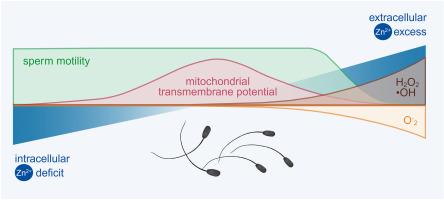锌在猪精子的线粒体功能、运动和质膜组织中起重要作用
IF 2.5
2区 农林科学
Q3 REPRODUCTIVE BIOLOGY
引用次数: 0
摘要
锌是猪精浆中含量最丰富的微量元素。目前的体外研究调查了猪精子中线粒体功能、运动性和质膜组织在多大程度上取决于细胞外和细胞内Zn2+的存在。精子在化学定义的培养基中孵育,增加浓度的ZnCl2 (0.01-2 mM)或细胞内锌螯合剂TPEN (0.01-1000 μM)的存在。在不补充锌的情况下,细胞外Zn2+水平(≥1 mM)阻止了细胞内游离Zn2+水平随时间的下调(P < 0.05)。同时,细胞外Zn2+导致活精子线粒体跨膜电位呈剂量依赖性降低(P < 0.05)。在Zn2+浓度最高时,精子活力几乎不存在(P < 0.05)。Ca2+和Mg2+均无相似效果(P > 0.05)。值得注意的是,细胞外Zn2+诱导活精子中细胞羟基自由基和过氧化物水平持续、剂量依赖性地增加(P < 0.05),同时降低细胞和线粒体超氧化物水平。游离细胞内锌与TPEN的螯合作用使活精子的线粒体跨膜电位降低高达60% (P < 0.05)。高TPEN浓度对精子活力的负面影响很明显,但在不同的实验运行中强度不同。TPEN持续降低细胞超氧化物水平,并在长时间孵育后,在活精子中增加细胞羟基自由基和过氧化物水平。锌与咖啡因具有显著的协同作用,可提高高膜流动性精子的存活率。总之,这些结果强调了锌作为猪精子线粒体功能和活性氧平衡的重要因素的重要性。本文章由计算机程序翻译,如有差异,请以英文原文为准。

Zinc plays an essential role in mitochondrial function, motility and plasma membrane organisation of boar spermatozoa
Zinc is the most abundant trace element in boar seminal plasma. The current in vitro study investigated to which extent mitochondrial function, motility, and plasma membrane organization depend on the presence of extra- and intracellular Zn2+ in boar spermatozoa. Spermatozoa were incubated in chemically-defined media in the presence of increasing concentrations of ZnCl2 (0.01–2 mM) or TPEN, an intracellular zinc chelator (0.01–1000 μM). Extracellular Zn2+-levels (≥1 mM) prevented the downregulation of free intracellular Zn2+ levels over time (P < 0.05) observed in the absence of zinc supplementation. Concomitantly, extracellular Zn2+ led to a dose-dependent reduction in mitochondrial transmembrane potential in viable spermatozoa (P < 0.05). At the highest Zn2+ concentrations, sperm motility was virtually absent (P < 0.05). Neither Ca2+ nor Mg2+ had a similar effect (P > 0.05). Notably, extracellular Zn2+ induced a persistent, dose-dependent increase in cellular hydroxyl radical and peroxide levels in viable spermatozoa (P < 0.05), while simultaneously decreasing cellular and mitochondrial superoxide levels. Chelation of free intracellular zinc with TPEN decreased the mitochondrial transmembrane potential in viable sperm by up to 60 % (P < 0.05). Negative effects on sperm motility were apparent with high TPEN concentrations, but varied in intensity between experimental runs. TPEN consistently reduced cellular superoxide levels and, after prolonged incubation, increased cellular hydroxyl radical and peroxide levels in viable spermatozoa. Zinc showed a significant synergistic effect with caffeine to increase the percentage of viable spermatozoa with high membrane fluidity. Altogether, the results underscore the importance of zinc as an essential factor for mitochondrial function and balance of reactive oxygen species in boar spermatozoa.
求助全文
通过发布文献求助,成功后即可免费获取论文全文。
去求助
来源期刊

Theriogenology
农林科学-生殖生物学
CiteScore
5.50
自引率
14.30%
发文量
387
审稿时长
72 days
期刊介绍:
Theriogenology provides an international forum for researchers, clinicians, and industry professionals in animal reproductive biology. This acclaimed journal publishes articles on a wide range of topics in reproductive and developmental biology, of domestic mammal, avian, and aquatic species as well as wild species which are the object of veterinary care in research or conservation programs.
 求助内容:
求助内容: 应助结果提醒方式:
应助结果提醒方式:


